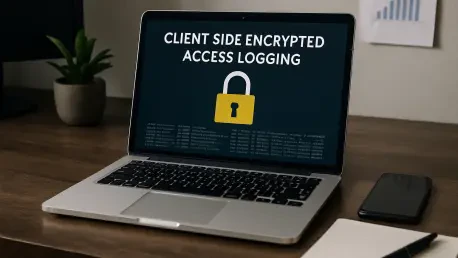In an era where digital interactions dominate daily life, the security of online accounts stands as a paramount concern, especially with cyber threats growing more sophisticated by the day. Hackers continuously exploit vulnerabilities, leaving personal data exposed and users at risk of identity theft or worse. Amid this alarming landscape, a pioneering solution known as Client-Side Encrypted Access Logging (CSAL), developed by researchers at Cornell Tech, emerges as a beacon of hope. Unveiled at a prominent security symposium, this system addresses the critical flaws in traditional access logging methods while prioritizing user privacy through innovative encryption techniques. Unlike conventional approaches that often fail to detect unauthorized access or protect sensitive information, CSAL offers a transformative framework that empowers individuals to safeguard their digital identities. This article explores the profound impact of CSAL, delving into its mechanisms, its response to existing security gaps, and its broader implications for the future of online protection.
Unmasking the Flaws in Conventional Security Systems
Traditional access logging systems, widely implemented by major tech platforms, have long been trusted to monitor and report login activities, but they harbor significant weaknesses that undermine their effectiveness. These systems depend heavily on client-side data like IP addresses and device identifiers to track user logins. Unfortunately, such information can be easily manipulated by skilled attackers, who spoof these details to mask their unauthorized access. This creates a deceptive illusion of safety for users who rely on login histories to detect suspicious behavior, often unaware that the data they trust has been tampered with. The consequences of such breaches extend beyond mere inconvenience, potentially leading to stolen personal information or compromised financial accounts. For many, this vulnerability shatters confidence in the very tools meant to protect them, exposing a critical gap in digital security that demands urgent attention and innovative solutions to restore trust.
Moreover, the risks posed by these flawed systems are disproportionately severe for certain groups, such as journalists, activists, and public figures, whose online accounts are high-value targets for malicious actors. A single breach in their digital defenses can result in devastating real-world outcomes, including threats to personal safety or the exposure of sensitive communications. Traditional logging methods fail to provide the robust protection these individuals desperately need, often leaving them vulnerable to sophisticated cyber-attacks that exploit outdated security measures. This glaring inadequacy highlights the pressing need for a paradigm shift in how online account access is monitored and secured. Without a reliable mechanism to detect and prevent unauthorized logins, the digital landscape remains a perilous terrain for those most at risk, underscoring the importance of developing advanced systems capable of addressing these entrenched security challenges.
CSAL’s Innovative Approach to Enhanced Protection
Client-Side Encrypted Access Logging (CSAL) introduces a groundbreaking method to tackle the inherent shortcomings of traditional security systems by leveraging a cryptographic framework that prioritizes user empowerment. Rather than transmitting sensitive data like device identifiers to external servers, CSAL generates encrypted tokens that encapsulate login information, keeping it securely under the user’s control. This means that only the account holder can decrypt and review their login history, ensuring a far more accurate detection of unauthorized access. By sidestepping the vulnerabilities tied to spoofable data points, this system offers a reliable alternative that significantly reduces the chances of attackers going unnoticed. The shift to a user-centric model not only bolsters security but also rebuilds trust in digital interactions, providing a robust defense against the evolving tactics of cybercriminals targeting online accounts.
Beyond its technical innovation, CSAL stands out for its practical applicability across diverse platforms, making it a feasible solution for widespread adoption in the realm of cybersecurity. The system has been designed to integrate seamlessly with existing authentication protocols, minimizing disruption for service providers while maximizing protection for users. This compatibility addresses a common barrier to implementing new security measures, as many organizations hesitate to overhaul established frameworks due to cost or complexity. For high-risk individuals, such as those in professions prone to digital targeting, CSAL’s ability to deliver precise and trustworthy login verification can be a game-changer, offering peace of mind in an otherwise hostile online environment. Its focus on balancing enhanced security with operational ease positions CSAL as a forward-thinking tool that could redefine industry standards for safeguarding digital identities against unauthorized intrusions.
Prioritizing Privacy in a Data-Driven World
A defining strength of CSAL lies in its resolute commitment to preserving user privacy, a principle often sidelined in conventional security systems that expose personal data to external entities. By employing end-to-end encryption, this innovative system ensures that sensitive information, such as login details or device specifics, never leaves the user’s device in an unencrypted form. This approach directly challenges the pervasive data collection practices seen across much of the tech industry, where user information is frequently harvested for operational or commercial purposes. CSAL flips this dynamic by placing control squarely in the hands of individuals, allowing them to monitor their account activity without fear of unwanted surveillance. In an age where privacy concerns are at an all-time high, this system aligns with the growing public demand for greater transparency and autonomy over personal data in digital spaces.
Furthermore, the privacy-first design of CSAL addresses a critical ethical concern surrounding the balance between security and individual rights, particularly for users wary of invasive tracking by service providers. By minimizing the exposure of personal information to external servers, the system reduces the risk of data being misused or falling into the wrong hands during a breach. This is especially vital for those who operate in high-stakes environments, where the unauthorized disclosure of digital activity could have severe repercussions. CSAL’s emphasis on safeguarding privacy while maintaining robust security measures sets a new benchmark for how online platforms can protect users without compromising their fundamental right to control their own data. As digital interactions continue to expand, such a model serves as a compelling blueprint for fostering trust and accountability between users and the technologies they rely on daily.
Shaping the Future of Digital Defense
Reflecting on the journey of Client-Side Encrypted Access Logging, it’s evident that the system marks a pivotal moment in addressing the longstanding vulnerabilities of traditional access logging methods. Developed with a keen focus on user empowerment, CSAL tackles the deceptive reliability of spoofable data through its cryptographic innovation, ensuring that unauthorized access can be detected with unprecedented accuracy. Its staunch dedication to privacy via end-to-end encryption also challenges the invasive norms of data handling, offering a safer alternative for users worldwide. The seamless integration with existing security protocols further demonstrates its practicality, paving the way for potential adoption by major platforms. Looking ahead, the legacy of CSAL lies in inspiring continuous advancements in cybersecurity. Stakeholders are encouraged to build on this foundation by exploring further applications of privacy-preserving technologies and advocating for user-centric designs. As cyber threats persist, embracing such solutions will be crucial to crafting a digital landscape where security and personal autonomy coexist harmoniously.









